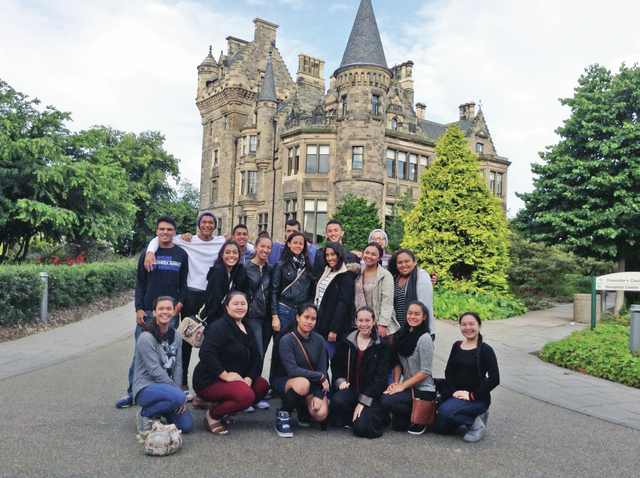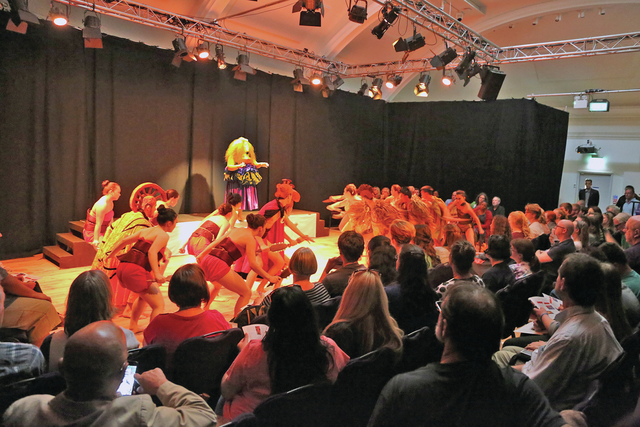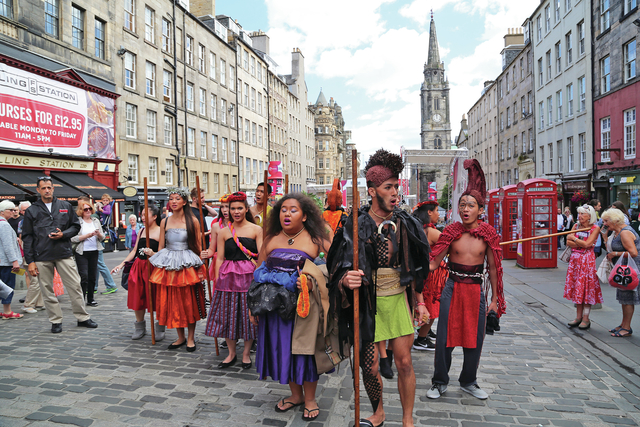Two hours.
That’s all the time the group from Kamehameha Schools Hawaii had to prepare their set, perform their show, and break everything down.
They’d had exactly one rehearsal in the small theater space of Space Triplex, one of hundreds of venues set up in Edinburgh, Scotland, during the annual Festival Fringe. More than 50,000 performers take part in the festival. More than 1 million people attend.
Within the larger festival is the American High School Theatre Festival, which features 50 high schools from around the country. This year, one of those was Kamehameha, performing “Ha‘upu,” an original opera written by school music director Herb Mahelona and based on the story of Hina and Kapepeekauila.
It is the first-ever Hawaiian language piece to be presented at Festival Fringe.
“We’re still there in our minds,” senior Makana Waikiki, one of the 19 cast members, said Thursday, less than a week after the group’s whirlwind two-week trip through Great Britain. They could still see the cars driving on the opposite side of the road, the brick buildings, the sun that didn’t set until 10 p.m.
And they could still see the small Space Triplex stage, a far cry from the Kamehameha Schools gymnasium where Ha‘upu was first performed, and the even more cramped backstage, where senior Daylan Kalai’s ti-leaf cape rustled as he navigated the narrow makeshift hallway.
The first performances of Ha‘upu took place on campus, with the entire school participating. The show had to be downsized to go on the road: everything fit into six crates, and cast members packed their own costumes in their carry-on bags.
The group gave four performances during the festival. All brought different memories.
“The first show was the coolest, because we’d waited and waited and waited and waited for so long, and we’d worked and worked,” Waikiki said. “And then it happened, so it was kind of like — we just did that.”
They were a bit jet-lagged before that show, recovering from 27 hours of travel from the Big Island to the British Isles, two days of London sightseeing and a 10-hour bus ride to Edinburgh.
“Ha‘upu” was one of two shows the festival organizers had chosen to showcase AHSTF for school directors who were considering attending next year.
“I’ve never been that nervous in my life,” said Pono Brown, a 2016 graduate.
Brown’s sister Hiwa, a junior, had the opposite feeling.
“I thought we were really ready,” she said.
“The cast hadn’t really performed anything outside of this area,” show director Eric Stack said. “The audience here are very receptive, very nice. You take it to another place, and it gets nerve-wracking. They didn’t necessarily have to accept what we were performing.”
The students went into their show with a clear sense of all that they were representing — the school, the state, the Hawaiian language, stories and people — and a similar sense that “what we hope to present will successfully come across,” as Kalai put it.
They still could hear the first rings of applause from the first standing ovation (there were two) they got after the debut performance. The crowd wanted an encore, but the students had to change quickly and get the set down.
After the second show, a teacher from a Connecticut school approached junior Pomai Longakit, crying.
“He has family from Hawaii and was saying what we’re doing is amazing,” Longakit said. “He couldn’t speak; he was so overwhelmed…you don’t realize how much the show can affect someone.”
One school group from Texas had students come to every show. At the AHSTF office, a worker told hula choreographer Kelii Grothmann congratulations: The kids were “creating a buzz.”
“I think because our show applies to emotions that not just Hawaiian people have,” Waikiki said. “They were able to connect even though they didn’t know what we were saying. We knew what we were saying, and that come through.”
It had taken more than a year of preparations to get to that point (when the group learned they’d be going to Scotland, Mahelona hadn’t actually finished writing the opera yet). There were auditions to complete; rehearsals; mele, oli, and hula to learn; costumes to make; more rehearsals; and thousands of dollars to fund-raise for the trip costs. It took an island, cast members said.
“It wasn’t just people who donated money, it was the people who came to our (Hawaii) shows, helped spread the word, gave us compliments, kept us motivated,” Waikiki said.
The Kamehameha students brought Hawaii with them on their trip, but they also found it along the way. In Scotland, they visited Colinton Parish, visiting the church Kauilani and Robert Louis Stevenson once attended.
“A lot of people there have connections to the monarch because their ancestors actually met them in person,” Grothmann said. “It’s a very spiritually heavy place for us.”
In London, a small group had a special tour of the British Museum, where they were able to see artifacts from Captain Cook’s time.
Junior Kuuhiapo Jeong described the visit as “like seeing your long-lost family, and know that they’re okay.”
“You’re able to connect back to your roots,” he said.
Waikiki was struck by how well-preserved the artifacts were, particularly the feather mahiole (helmets).
“They looked like they were just given,” she said.
On Aug. 10, the students returned to tiny Space Triplex for the final show.
“We knew it was the last show we’d ever do,” Jeong said. “Everything comes down to this last moment, and once we took that last bow, we were in tears.”
“I don’t think I would change a single thing about the shows,” said senior Alya Kanehailua. “I don’t think I’ll ever have an experience like that again.”
Email Ivy Ashe at iashe@hawaiitribune-herald.com.








